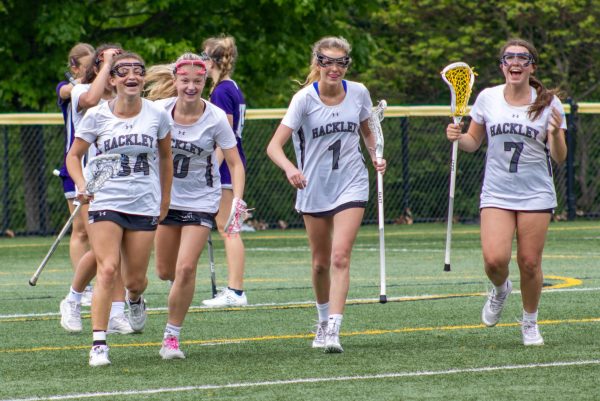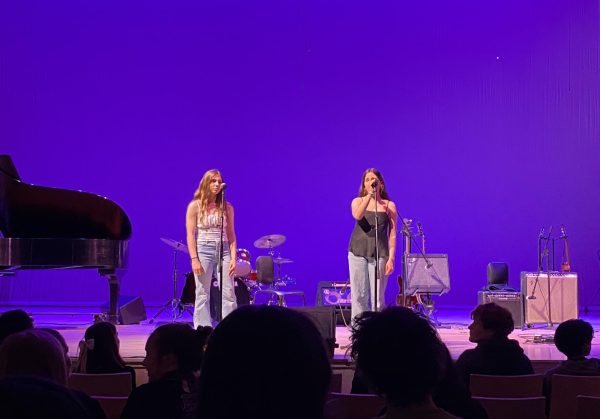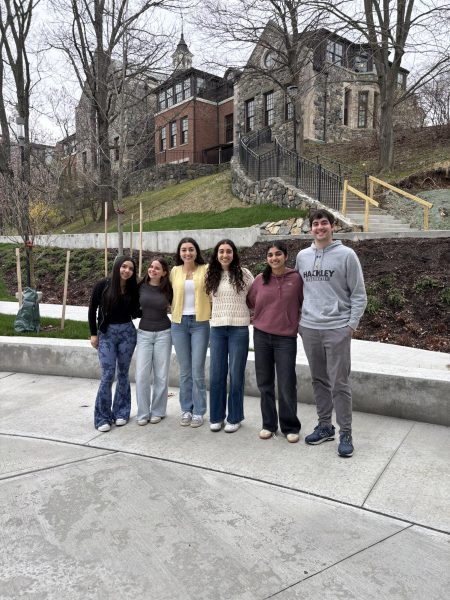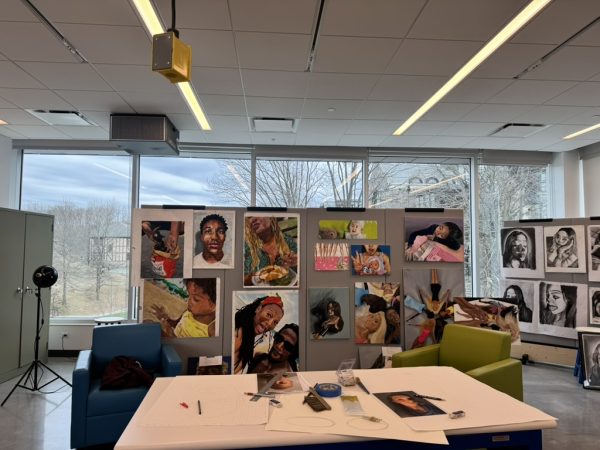A hate symbol promotes conversation on campus; action must follow
[infogram id=”250f2ab9-bcdb-49ef-9bb5-f07cb82d53fb” format=”interactive” title=”Editorial”]
On Wednesday, March 13th, Upper School students received an email that stated that they were to report to the Johnson Center during their break period. The calling of the entire Upper School to a meeting with little notice was an unusual occurrence, and the halls were buzzing with rumors about the topic of the meeting.
Almost all were surprised by the uncomfortable truth that was revealed at the meeting: A swastika the size of a dime had been carved into one of the school’s wooden classroom tables.
This small symbol shined a light on the darker side of Hackley’s culture. It showed what would never be said in a classroom might be said elsewhere. The hatred at Hackley may exist in the shadows, but it must nevertheless be eradicated.
“You just wouldn’t expect for this to happen in 2019, in Westchester, at a place like Hackley,” junior Sophia Masotti said. “A lot of people make jokes about race, but that doesn’t necessarily mean they are racist they could just be unaware of the consequences and the meaning of what they are saying. I can’t imagine anyone here being outwardly racist or drawing something like that seriously.”
While we hope this is true, it is unclear what the intent of the drawing was, which is part of what makes the incident so challenging and upsetting.
WHAT HAS BEEN DONE
At the Wednesday, March 13th, assembly, Upper School Head Andy King addressed the student body to explain the incident and its gravity as well as the administration’s belief that this kind of hatred is absolutely unacceptable. Freshman Phoebe Naughton said, “Mr. King was really powerful. He forced me and the rest of the school to pause and think.”
After King’s address, various members of the faculty including the Head of School, facilitated discussions about hate at school. Head of School Michael Wirtz later met with the seniors and juniors and answered questions about what the administration’s response would be and how things would change.
Mr. Wirtz also held a roundtable discussion in the Lindsay Room that day. During the discussion, students were encouraged to express any and all thoughts regarding the incident and its effect on the Hackley community. A number of students noted that hate speech had been permeating the Hilltop prior to the swastika incident.
Generally speaking, Hackley is not a homophobic, sexist, racist or an anti-Semitic community. But while Hackley is by and large an accepting community, it clearly still has work to do.
“This is in some ways a very sobering moment for a lot of us. We talk a lot about entering here to be and find a friend and I think on the whole students are extraordinarily warm and welcoming. But this was certainly not a very welcoming action,” Mr. King said.
WHAT MUST BE DONE
- By the Administration
The Dial Editorial Board urges Hackley’s administration to continue to pursue the essential balance between maintaining free speech for its students while also ensuring a reduction in hate speech on campus. Additionally, Hackley should not brush off this event as a “one-time incident” but rather recognize that these attacks may occur but will not be tolerated in the future.
The Editorial Board believes in the assumption that the use of slurs, stereotypes or other hateful language in a public space such as Hackley should warrant strong repercussions.
Hate speech is a complex topic, and its nuances make it difficult to prescribe a one-size-fits-all punishment. Yet, the Dial encourages the administration to punish those who attack others based on identity strongly. However, Hackley exists with the goal of educating, with that as the end goal, these offenders must come to understand the seriousness and the historical injustices that make their statements so significant.
The administration must do a better job in ensuring that each of these incidents is taken seriously and showing with action that hatred is not tolerated.
“I think transparency and paying attention to optics are important,” said 2019-2020 school president-elect Taylor Robin, “Since there is not as much transparency in these kinds of cases then I think people assume what is going on. The administration has to understand that these cases can look really bad to students, especially students of color, or students directly impacted by the situation. Those students need some sort of assurance that something is being done and that students are being protected.”
Robin has personally experienced other instances of hate speech and has been extremely vocal with the administration. In addition, addressing this issue was part of her campaign platform.
Preventative action is also important and many of the ways in which the school could do this were suggested at meetings held by Mr. King and Mr. Wirtz: Mandatory anti-bias education and increased transparency in the discipline system would be beneficial. Mr. King also spoke of peer advisors as another way to give students the skills necessary to handle and combat hate speech. Another interesting strategy being considered is bringing anti-bias education into the classroom through literature examined or history studied.
This learning needs to become a priority. “Some of the problems I’ve run into especially when I’m pushing for diversity surrounded events is there is simply not enough time. But the issue with that, is we need to make time. That is not a good enough excuse. I understand there are time constraints and I respect that but this is not a class, this is about character development.” said Taylor.
Mr. King and the administration as a whole has made promises to do so but we urge them to follow through.
It is also crucial to continue the discussion as hearing and understanding their peers’ viewpoints helps the student body as a whole be more empathetic as well as aware of the impact of their words.
“We should be having more difficult conversations to show things like this do affect and do hurt people,” freshman Kaitlyn Qu said. “A lot of students think that the difficult conversations are necessary but they don’t want to have them. But I think that they will do something and I believe that students can be serious when they really want to and I think we can be thoughtful about these things.”
The benefits of these conversations Taylor said are that “People will have enough information going into situations where hateful things are said where they will know that these things aren’t funny and how to respond. And, by having these conversations way more frequently I think we will have way less of these situations happening.”
- By the students
The administration can only do so much; responsibility also lies with the student body. If we aspire to be a place of acceptance we must embody it ourselves. As Mr. King said, “Constant vigilance and action are ever needed.”
Hate doesn’t have a home in our classrooms due in part to our teachers. As students, we can no longer allow hate to exist in our hallways, and locker rooms. Students with privilege must do a better job of sticking up for their peers who may be subject to language, joking or not, that attacks their identity.
Student culture is shaped by students and we all must work to make sure everyone in our community feels that their identity is accepted.
This swastika succeeded in starting an important conversation about the culture of Hackley. It is important that a conversation has begun, but action must follow. As Mr. King said, “We must do better.”







